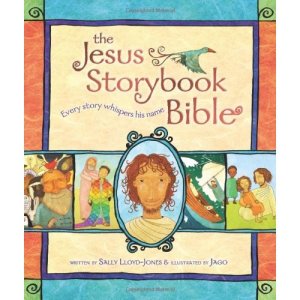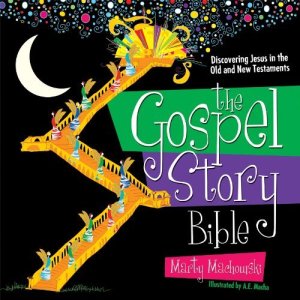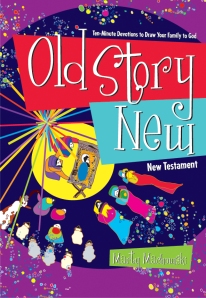Adventures in Family Devotions: Wrap-up
This is the final post in our series on Family Devotions. Today is the last day to comment on the Old Story New post to qualify for a free copy of the book. All comments must be in by midnight (EST).
Just like every child is different, every family is different. There is no magic bullet for family devotions. The best practices are the ones that work for your family. If you check out the comments over at the Old Story New post, you will likely find that you are not alone in your struggles. There is some great encouragement there, it's well worth your time to check it out. In conclusion, this week I thought I would share two ideas that have really helped Angie and me.
The first idea has to do with the church calendar. If you come from an independent church background you may not be familiar with the rhythms of the church year. I would recommend any of Robert Webber's resources, especially Ancient-Future Time. The way we do this is through the last song we sing each evening. For each season of the church year, we sing a different song. So for Advent, Lent, Easter, and Kingdomtide we sing O Come, O Come Immanuel, When I survey the Wondrous Cross, Christ the Lord is Risen Today, and the Lord's prayer. During regular time, we sing the Doxology. This rhythm has been very easy to maintain and has lead to some great teaching times.
The second thing our family has learned is to vary things up. If family devotions are the exact same every night, you and your kids will get tired of them. Keep their attention. Change the format, sing first and do Bible reading second. Change the location, do it in the kids rooms or the living room. We even have “upside-down devotions” some nights. However it works, just keep things a surprise.
Above all, the best family devotions are the ones that you do. Don't jump in and expect utopian kids from the get-go. Start small, a couple times a week
The Jesus Storybook Bible and the Gospel Story Bible
As we continue our look at family devotions, I wanted to take time out to talk about two fantastic resources for your family. Don’t forget that you can win one of two copies of Old Story New by commenting on Monday’s post.
Have you ever wished that somebody would release a product and the next time you turn around there is not one but two? For instance, if a few years ago you wished for a rewrite of Jane Austin to compete with the banal teen paranormal fiction that flooded the shelves, you would have had nothing. Then, BAM, Sense & Sensibility & Sea-Monsters AND Pride & Prejudice & Zombies both hit the market.
For a long time, parents were confined to children’s Bibles that bordered on ridiculous. Whether it was the “Bernstein Bear Bible” or the “Rhyme Time Bible” or any other children’s Bible, they all had several flaws. Some were so concerned with style, or rhyming, that they glossed over the actual point of the Bible Stories. Others did a great job telling the stories of scripture, if your measuring stick for “great job” is turning the stories into Aesop’s Fables. The options were either non-sense or moralism. Parents had to work hard to help the Bible’s along.
 Over the past few years, this has changed. Two new children’s Bibles have been published and both are excellent! The Jesus Storybook Bible and the Gospel Story Bible would both be an asset to any family. The Jesus Storybook Bible is written by Sally Lloyd-Jones and is the product of applying the teachings of Tim Keller and Redeemer Presbyterian Church in New York City to a children’s Bible. The Gospel Story Bible, by Marty Machowski, comes from a Sovereign Grace church near Philadelphia. Both of these books are Christ-centered and look at every story through the lens of redemption.
Over the past few years, this has changed. Two new children’s Bibles have been published and both are excellent! The Jesus Storybook Bible and the Gospel Story Bible would both be an asset to any family. The Jesus Storybook Bible is written by Sally Lloyd-Jones and is the product of applying the teachings of Tim Keller and Redeemer Presbyterian Church in New York City to a children’s Bible. The Gospel Story Bible, by Marty Machowski, comes from a Sovereign Grace church near Philadelphia. Both of these books are Christ-centered and look at every story through the lens of redemption.
The artwork in both books is very different, but very good. Jesus Storybook Bible was illustrated by Jago and features very stylized hand done drawings. Everything is rounded and fun. The colors are slightly muted and the text of the stories flows in with the art. This is particularly beautiful in the rendering of Psalm 23. The artwork in Gospel Story Bible, by A.E. Macha, looks a bit more modern. The colors slightly more vibrant, but the illustrations are limited (by in large) to one page opposite the story on the facing page.
The books are both meant for children, though each has strengths for different age groups. The Jesus Storybook Bible is more poetic in the way that it tells stories. It’s not singsongy like a Dr. Suess book, but it does compact a lot of meaning into a few words. It also spreads the stories out onto multiple pages. This is a big deal for parents of preschoolers. Turning pages is very important. On the other hand, The Gospel Story Bible takes time to explain many of the whys behind the stories. For instance, the story of Jesus washing his disciples feet includes a paragraph on the role of servants. Each of the stories is on a single page with an illustration on the facing page. There is far more to each story when compared to the Jesus Storybook Bible, but no page turning. Overall, the page turning and language of the Jesus Storybook Bible lends itself to preschoolers and the depth of each story in the Gospel Story Bible favors middle elementary school children.
Both of these books are reformed, Christ-centered, and gospel-focused. You can’t go wrong with the content of either.
 The Gospel Story Bible is setup in 156 stories with 78 of those coming from each testament. The idea would be to study each story for a week, using the devotionals that correspond to the Bible. This means your family could spend 18 months in the Old and New Testaments. The Jesus Storybook Bible is setup more like a traditional children’s Bible. It includes the “greatest hits” for kids; stories like Jonah, Namaan, and David. It only has 44 lessons, divided evenly between the Old and New Testaments. If you spent a week on each story, you could complete the entire cycle in just under a year.
The Gospel Story Bible is setup in 156 stories with 78 of those coming from each testament. The idea would be to study each story for a week, using the devotionals that correspond to the Bible. This means your family could spend 18 months in the Old and New Testaments. The Jesus Storybook Bible is setup more like a traditional children’s Bible. It includes the “greatest hits” for kids; stories like Jonah, Namaan, and David. It only has 44 lessons, divided evenly between the Old and New Testaments. If you spent a week on each story, you could complete the entire cycle in just under a year.
So what do these two books cost? The Jesus Storybook Bible can be had for around $10 from a variety of online retailers. The Gospel Story Bible is a little pricier, selling for around $20 with the publisher having as good a deal as anyone.
So which of these two great Bibles are best for your family? The simple answer is the one you will read. If you prefer one, great! If you are still looking for something to tip the scales, I would point to the age of your children. If your kids are in preschool, go with the Jesus Storybook Bible. If you have older children, you should consider the Gospel Story Bible.
Adventures in Family Devotions: Old Story New
Last week, I wrote about my first experience with Family Devotions and some of my failures. Today, I would like to share a new book written to help folks like me.
If you have been reading along with the post last week, you know that my experience with family worship has been a pendulum between big ideals and difficult implementation. I get the feeling that most regular people like us struggle with this. Unless you are a super-parent or have angelic children, family devotions are hard. That probably bears repeating, because it is encouraging to remember that it is a struggle for others.
There is no silver bullet that will make kids sit quietly at night. There is no magic potion which will make your 4 year old engage with you and the Bible each evening. Corralling all the kids before the earliest of bedtimes can be a tough task. Thankfully there is a new resource to help out parents like us. With kids like ours.
Marty Machowski is a pastor who is the author of the Gospel Story Bible. Along with this he has helped to design a 3 year curriculum based on the Gospel Story Bible. Last year New Growth Press released Long Story Short, the Old Testament companion to Old Story New.
Old Story New corresponds to the 78 New Testament stories of the Gospel Story Bible. Each story has 5 evenings worth of lessons (which easily correspond to school-nights) in Old Story New. These nightly lessons are not overly long or complex. Each week contains a sort of rhythm that goes like this:
- Sunday: The story of the week is introduced. There are vivid modern stories and illustrations that help your kids understand the story for the week.
- Monday: There is a short review followed by a chance for your family to dig deeper into the story for the week.
- Tuesday: This lesson always focusses on connecting the story to the gospel of Jesus Christ.
- Wednesday: This lesson is similar to Tuesday, exploring the passage. But each week there is a prompt for the kids to ask the parents a question about how the story connects to their loves. This is a fantastic exercise.
- Thursday: The final lesson of the week always branches out to the Old Testament to connect the story to the Psalms and Prophets.
Each day also contains questions, with the answers already written in. Additionally, there is a prayer starter every day. This layout and pattern makes it incredibly simple for anyone to begin to have family devotion time with their kids. Even parents who may be young in their faith can use this devotional. It keeps us from accidentally moralizing the stories. By providing answers, it also helps parents stay focussed in pointing their children to Jesus.
Another strength of Old Story New is the connection to the Bible. While the lessons are based in the Gospel Story Bible, the readings each night of from mom and dad’s Bible. This is incredibly important. Most family devotions are either based solely on some sort of children’s Bible, or solely on mom and dad’s Bible. Old Story New is based on the stories out of the companion children’s Bible, but each day has a reading from scripture. This balance is the best part of the devotional. While our children may not understand every word, they can begin at a young age to engage the scriptures. Old Story New gives parents handles for introducing their kids to the Bible.
The book is aimed at elementary aged kids, though there are some helpful tips on adapting it to younger or older children. But it is ideal for a kids in the middle of elementary school (ages 6-10). If your church uses the Gospel Story curriculum, like we do here at Surfside, the devotional is a perfect companion. Students are introduced to the story at church and then through the week look at it again with their parents.
I highly recommend Old Story New for your family. It is an incredible resource and companion to the New Growth Press children’s resources. You can click here to pick up a copy from New Growth Press (cheaper than Amazon!)
Or even better, Get One for Free! Leave a comment here about one of your failures or successes in family devotions; or tell us about the best idea for family worship you have seen. Next Monday, I will randomly select two of the comments and send them a free copy of Old Story New!
Adventures in Family Devotions: (Mis)Adventures and Failures
Next week, I will be featuring a review of the New Growth Press family devotional called, “Old Story New“. Leading up to that, I thought I would share some of my adventures in family devotions. Earlier this week, I wrote about my first experiences with Family Devotions, you can read about it here.
 There is an old Scottish story of a rich young ruler. As he was courting women, he was famous for saying that he had many theories on raising children. Then he got married and started having kids. A few years later a friend asked him how the family was going. The now middle aged Scot replied, “Before I was married I had 4 different theories on raising children. Now I have 4 children and no theories.”
There is an old Scottish story of a rich young ruler. As he was courting women, he was famous for saying that he had many theories on raising children. Then he got married and started having kids. A few years later a friend asked him how the family was going. The now middle aged Scot replied, “Before I was married I had 4 different theories on raising children. Now I have 4 children and no theories.”
When it comes to family devotions, I sometimes feel like this. I had all kinds of ideas and ideals. I had the “Barcott Template” from seminary. I had a children’s Bible, and a heart full of the best intentions. So about the time our oldest son transitioned to a toddler bed, I decided we would start to read a story from the Jesus Storybook Bible. My two year old was unimpressed. I would try to shorten the stories, but he would still not want to listen. One night I can remember calling him up onto my lap to read our story. He obliged after some light bribery. As I tried to read him the most exciting story I could think of, Jonah and the Whale, he was twisting and squirming. I pressed on, reading the story and holding him a little tighter, encouraging him to sit still. This battle of wills ended in my son head-butting me, breaking my glasses. In half.
So we decided to abandoned the story time model. Instead, we began using the Children’s Catechism to work through each night. At first this was great. Our son was taking to it great. Each night we would review the previous questions and work on the newest question. This was all going fantastic until we got to question 30 or so and our son insisted on going through every question, every night. All of the sudden, our nightly family devotional time was stretching to 20 or 30 minutes. And we were just going through the motions of the avalanche of questions and answers.
O yeah, and one time, my son gave me a flying elbow drop in the middle of question 18.
It sure seemed like every idea my wife and I had for family devotions ended in pain and destruction in the most literal sense. We were at the end of our rope, ready to give up on the idea of family devotions.
Adventures in Family Devotions: The Prologue
Next week, I will be featuring a review of the New Growth Press family devotional called, “Old Story New“. Leading up to that, I thought I would share some of my adventures in family devotions.
While I was in seminary, I had to travel between Tampa and Orlando. This trip made it necessary for me to find somewhere to crash on the nights between classes. I was grateful to my friend Adam and his family for putting me up and putting up with me. Adam had a great family who I grew to love. I learned so much from Adam and his wife, Val, about being a parent. As an only child, I was always a little scared of kids.
With all the slobber, mispronunciation, and blind trust, who wouldn't be scared.
So as I would spend time at Adam and Val's house, I had the chance to watch the way they had family devotions. At exactly 8 every night, their kids (at the time, a 7-year old girl, 4-year old boy, and 2-year old girl) would gather around the couch. All electronics would be turned off and they would have their family devotions together.
I can remember the first few times I saw them gather as a family, I was a little weirded out. The intimacy that I was being let into was not something I was accustomed to.
And yet Adam and Val would gather their remarkably well behaved children to the room. They would read the Bible, work on memory verses, sing songs, and pray together. The kids never acted up. Even Grace, the 2-year old, seemed to actively participate. It was like a magic Jesus utopia of family time. They made it look so easy.
After I got over the awkwardness of watching this all from the sidelines, I resolved that when I had a family, I would do things just like Adam and Val.
I am sure that my memory is selective, but I wanted my families devotion times to be just like theirs. Which was the perfect plan…
…until I had kids of my own.
Tune in later this week to hear about all my failures!
Here’s to hoping Conner and Owen don’t punch lockers
So last night, the family and I rented the movie, “The Fighter”. I am not much of a boxing fan, but I really loved the movie. It was absolutely fantastic.
If you haven’t seen it, it traces the story of Mark Wahlberg and Christian Bale who play brothers who both box. Bale is significantly older, and after a bout with Sugar Ray Leonard descended into crack addiction. He spends the next 15 years in and out of prison. Along the way he has a son.
There is a particular scene in the movie that stood out to me. When Bale returns from jail he meets his brother in the gym locker room and his son is there too. Wahlberg breaks some tough news to Bale and then leaves. Bale responds to this by punching lockers.
And then it happens.
Bale’s son, who is only 3 or 4, starts punching lockers too.
Which brings me to my point. One of my greatest fears as a parent is that my bad habits and sins will manifest in my children. I see generational selfishness and manipulation, non-chalance and anger manifested in my life. As Conner grows into his own, I see it in him as well.
A few nights ago, he was up and playing when he should have been sleeping. I came into the room to talk to and discipline Conner. He knew he had done wrong. As soon as I walked in, he pointed to my shirt and started saying, “go Rays, daddy, homerun Rays!”. He knew that would make me happy and for a split second, it distracted me.
Again, as we were driving home, I was venting (read:yelling) in the car. I was terribly upset about something relatively insignificant, but boy was I venting. And in my anger I said something fairly inappropriate. Like a voice recorder, Conner piped up from the back seat and repeated what I had said.
He started punching lockers, like his daddy.
I am reminded of the terrifying idea in scripture that our sins are visited on our children, grandchildren and great grandchildren. And I am comforted by the fact that God’s covenant faithfulness extends to a thousand generations.
God, I need your faithfulness, because I sure don’t have any.
Expecting, just not that way
Editor’s Note: As part of my Lenten blogging streak, on Friday’s I will be focusing on family life. This series is meant to be a complement to my wife’s blog
It would be really easy to talk about our second son; but I am not going to. The amount of blogs about the transition from one child to two is legion, I am sure. Instead, I want to focus on the idea of expectations. Marriages live and die, flounder and flourish, thrive or starve, on the concept of our expectations. We are both victims and victimizers of our families based on our expectations. Maybe a “for instance” would be inline here. This is an interaction from this morning between my wife and I.
*We are waking up from a long night in the hospital, Angie in the hospital bed, me in the pull-out-bed/chair.
Angie: How’d you sleep?
Me: Meh (*shrugs) and you?
Angie: Better than last night.
Me: That’s not hard to beat, but yeah, me too. So what’s the plan for this morning?
Angie: Well, I’m gonna eat breakfast, then do my nurse checkup, then probably shower.
{At this point the story breaks up. In my mind the interaction sounded like this:
Angie: Are you going to get up? or just lay on that bed all morning?
*To which I think “Are you kidding!?! I have been slaving away all night to help you and this is what I get!? What do you expect me to do?
What Angie really said was,
Angie: You should probably get changed that way you are ready for the parade of nurses that are coming in here.
but I respond to the idea that she expected me to do more, to spring out of bed and change so I could do her list of things. I anticipated that Angie had a list of expectations for me and my behavior for the morning. I thought she needed me to get dressed so I could start meeting these expectations, so I responded poorly.
Justin: Fine, Fine! I’ll get dressed. I am getting dressed, what else should I do this morning?
This response immediately put Angie on the defensive. I expected that she would expect me to do certain things, then acted on those expectations. What resulted was anger and frustration. In reality, Angie was trying to save me the embarrassment of having a nurse or visitor walk in on me in my scivies.
And this is the thing: if I had lovingly listened to what Angie was saying, not what I (in my tiredness and anger) anticipated her saying; we would have had a good morning. Instead, I picked a fight that was completely unnecessary. We all have to learn to listen to one another; and listen for what the other person is actually saying. We (I especially) have to drop our expectations and let grace reign in our relationships.
Easier said than done; I expect.

